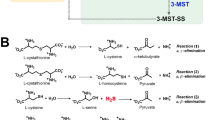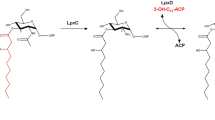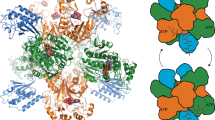Abstract
Isopenicillin N synthase (IPNS), a non-haem iron-dependent oxidase, catalyses the biosynthesis of isopenicillin N (IPN), the precursor of all penicillins and cephalosporins1. The key steps in this reaction are the two iron-dioxygen-mediated ring closures of the tripeptide δ-(L-α-aminoadipoyl)-L-cysteinyl-D-valine (ACV). It has been proposed that the four-membered β-lactam ring forms initially, associated with a highly oxidized iron(IV)-oxo (ferryl) moiety, which subsequently mediates closure of the five-membered thiazolidine ring2. Here we describe observation of the IPNS reaction in crystals by X-ray crystallography. IPNS·Fe2+·substrate crystals were grown anaerobically3,4, exposed to high pressures of oxygen to promote reaction and frozen, and their structures were elucidated by X-ray diffraction. Using the natural substrate ACV, this resulted in the IPNS·Fe2+·IPN product complex. With the substrate analogue, δ-(L-α-aminoadipoyl)-L-cysteinyl-L-S-methylcysteine (ACmC) in the crystal, the reaction cycle was interrupted at the monocyclic stage. These mono- and bicyclic structures support our hypothesis of a two-stage reaction sequence leading to penicillin. Furthermore, the formation of a monocyclic sulphoxide product from ACmC is most simply explained by the interception of a high-valency iron-oxo species.
This is a preview of subscription content, access via your institution
Access options
Subscribe to this journal
Receive 51 print issues and online access
$199.00 per year
only $3.90 per issue
Buy this article
- Purchase on Springer Link
- Instant access to full article PDF
Prices may be subject to local taxes which are calculated during checkout




Similar content being viewed by others
References
Baldwin,J. E. & Abraham,E. Biosynthesis of penicillins and cephalosporins. Nat. Prod. Rep. 5, 129–145 (1988).
Baldwin,J. E., Adlington,R. M., Moroney,S. E., Field,L. D. & Ting,H. H. Stepwise ring closure in penicillin biosynthesis. Initial beta-lactam formation. J. Chem. Soc. Chem. Commun. 984–986 (1984).
Roach,P. L. et al. Anaerobic crystallisation of an isopenicillin N synthase. Fe(II). substrate complex demonstrated by X-ray studies. Eur. J. Biochem. 242, 736–740 (1996).
Roach,P. L. et al. Structure of isopenicillin N synthase complexed with substrate and the mechanism of penicillin formation. Nature 387, 827–830 (1997).
Hajdu,J. & Andersson,I. Fast crystallography and time-resolved structures. Annu. Rev. Biophys. Biomol. Struct. 22, 467–498 (1993).
Kriauciunas,A. et al. The functional role of cysteines in isopenicillin N synthase. J. Biol. Chem. 266, 11779–11788 (1991).
Berendzen,J. et al. Crystal structures of reaction intermediates in cytochrome P450. Biophys. J. 74, A250 (1998).
Schlichting,I. et al. Crystal structures of intermediates occurring along the reaction pathway of cytochrome P450(cam). FASEB J. 11, P2 (1997).
Lee,S.-K., Nesheim,J. C. & Lipscomb,J. D. Transient intermediates of the methane monooxygenase catalytic cycle. J. Biol. Chem. 268, 21569–21577 (1993).
Baldwin,J. E., Adlington,R. M., Domayne-Hayman,B. P., Ting,H.-H. & Turner,N. J. Stereospecificity of carbon-sulphur bond formation in penicillin biosynthesis. J. Chem. Soc. Chem. Commun. 110–113 (1986).
Baldwin,J. E. & Bradley,M. Isopenicillin N synthase: mechanistic studies. Chem. Rev. 90, 1079–1088 (1990).
Rigau,J. J., Bacon,C. C. & Johnson,C. R. The stereochemistry of oxidation at sulfur. Oxidation of 2-methylthiolane. J. Org. Chem. 35, 3655–3657 (1970).
Baldwin,J. E. et al. Identification and characterisation of shunt metabolites from isopenicillin N synthase. J. Chem. Soc. Chem. Commun. 1125–1128 (1988).
Baldwin,J. E. et al. γ-Lactam formation from tripeptides with isopenicillin N synthase. J. Chem. Soc. Chem. Commun. 1128–1130 (1988).
Hadfield,A. & Hajdu,J. A fast and portable microspectrophotometer for protein crystallography. J. Appl. Crystallogr. 26, 839–842 (1993).
Otwinowski,Z. & Minor,W. Processing of X-ray diffraction data collected in oscillation mode. Methods Enzymol. 276, 307–326 (1997).
CCP4. The CCP4 suite: programs for protein crystallography. Acta Crystallogr. D 50, 760–763 (1994).
Sheldrick,G. M. & Schneider,T. R. SHELXL: High-resolution refinement. Methods Enzymol. 277, 319–343 (1997).
Jones,T. A., Zou,J. Y., Cowan,S. W. & Kjelgaard,M. Improved methods for building protein models in electron density maps and the location of errors in these models. Acta Crystallogr. A 47, 110–119 (1991).
Kraulis,P. J. Molscript—a program to produce both detailed and schematic plots of protein structures. J. Appl. Crystallogr. 24, 946–950 (1991).
Merritt,E. A. & Murphy,M. E. P. Raster3D Version 2.0—a program for photorealistic molecular graphics. Acta Crystallogr. D 50, 869–873 (1994).
Acknowledgements
We thank K. Harlos, C. Schofield, A. Long, J. Elkins, J. Ogle, P. Wright, R. Wilmouth, S. Lee, A. Salmeen, J. Pitt, J. Keeping and the scientists at SRS Daresbury, EMBL Hamburg and ESRF Grenoble for help and discussions. Financial support was provided by the MRC, BBSRC and ESPRC. P.L.R. thanks the Royal Society for financial support. N.I.B. was supported by a German DAAD fellowship. P.J.R. thanks the Rhodes Trust for support.
Author information
Authors and Affiliations
Corresponding author
Rights and permissions
About this article
Cite this article
Burzlaff, N., Rutledge, P., Clifton, I. et al. The reaction cycle of isopenicillin N synthase observed by X-ray diffraction. Nature 401, 721–724 (1999). https://doi.org/10.1038/44400
Received:
Accepted:
Issue Date:
DOI: https://doi.org/10.1038/44400
This article is cited by
-
Crystal structure and catalytic mechanism of the MbnBC holoenzyme required for methanobactin biosynthesis
Cell Research (2022)
-
Dioxygen activation by nonheme iron enzymes with the 2-His-1-carboxylate facial triad that generate high-valent oxoiron oxidants
JBIC Journal of Biological Inorganic Chemistry (2017)
-
Go it alone: four-electron oxidations by mononuclear non-heme iron enzymes
JBIC Journal of Biological Inorganic Chemistry (2017)
-
β-Lactam formation by a non-ribosomal peptide synthetase during antibiotic biosynthesis
Nature (2015)
-
Regio- and stereodivergent antibiotic oxidative carbocyclizations catalysed by Rieske oxygenase-like enzymes
Nature Chemistry (2011)
Comments
By submitting a comment you agree to abide by our Terms and Community Guidelines. If you find something abusive or that does not comply with our terms or guidelines please flag it as inappropriate.



